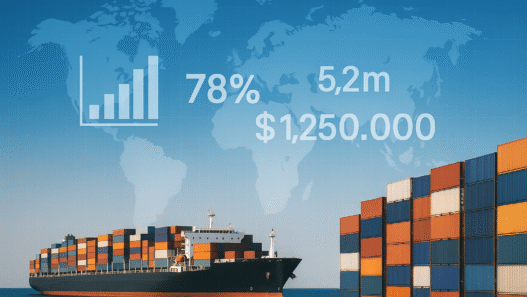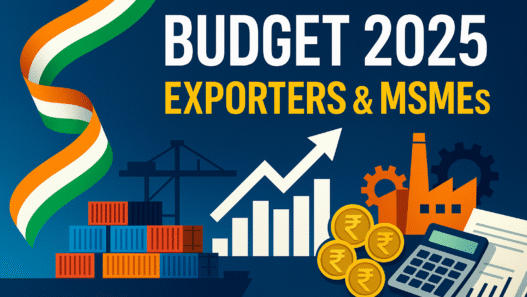The set-up: oil at ₹5 600 a barrel and counting
In the first week of June, benchmark Brent hovered near $68 (≈₹5 660) a barrel, about 15 % below January but still well above the long-term pre-pandemic norm. (eia.gov, eia.gov) On the same day, Drewry’s composite World Container Index (WCI) printed $3 543 for a 40-foot box, almost double its 2019 average. (drewry.co.uk) That simultaneous firmness in crude and freight neatly illustrates a rule of thumb every shipper learns the hard way: fuel costs ripple into every kilometre of logistics spend — ocean first, road next, and finally the air above us.
The chart below shows how annual average Brent prices have seesawed since the pandemic nadir.
Why fuel dominates the freight calculus
Sea freight. On a modern 14 000-TEU* container vessel, bunkers (the heavy fuel oil that now includes pricier very-low-sulphur blends) account for 45–55 % of operating expenditure according to Drewry’s latest Ship Operating Costs review (drewry.co.uk). Lines therefore pass volatility straight through via the Bunker Adjustment Factor (BAF) — a floating fee typically calculated as BAF = fuel price × trade factor. (hillebrandgori.com) Maersk’s October 2024 tariff table, for instance, lifted the Asia–Europe BAF by $82/TEU after a $100/tonne jump in IFO 380. (maersk.com)
Road freight. Diesel makes an even starker imprint. In India, fuel represents 50–60 % of a trucker’s cost base; a ₹5/litre hike can raise line-haul rates by ₹2–3 per km. (abctransport.co.in) Small fleet operators with thin margins mark up almost overnight, which is why delivery charges on an e-commerce parcel from Bhiwandi to Bengaluru still carry a “diesel surcharge” long after crude retreats.
Air freight. Jet-A1 prices move almost tick-for-tick with Brent. IATA’s Jet Fuel Price Monitor shows a global composite of $2.27/gal in early June, 14 % below a year ago but still 45 % above the 2015-19 mean. (iata.org) Airlines recover that delta via the fuel component of the TAC Index on major routes; from Mumbai (BOM) to Frankfurt (FRA) it currently stands at ₹37/kg, or roughly one-third of the all-in rate.
How the pass-through works
| Mode | Mechanism | Typical lag |
|---|---|---|
| Container shipping | Quarterly BAF/“emergency” bunker surcharge; some contracts use WCI-linked clauses | 2–6 weeks (faster on east-west head haul) |
| Bulk/LNG tanker | Voyage charter adjusts bunker directly; time-charterers pay at market | Immediate |
| Domestic trucking (IN) | Spot market reflates rates; 3PLs apply diesel escalation clause | 7–10 days |
| Courier & last-mile | Fuel surcharge pegged to city diesel average, revised monthly | 4 weeks |
| Air cargo | Fuel index (TAC/IATA) baked into rate sheets | Fortnightly |
TEU = Twenty-foot Equivalent Unit.
Flashbacks: five conflict-driven price shocks and what they did to freight
| Event | Brent spike | Immediate freight response | Last-mile echo |
|---|---|---|---|
| 1990 Iraq–Kuwait War | +128 % in 2 months | Asia–Europe BAF jumped $70/TEU (≈8 %) | Indian LTL* tariffs rose 6 % under diesel pass-through |
| 2003 Iraq invasion | +46 % in 4 months | Bulk freighters added $12 000 to voyage costs Arabian Gulf–WCI; container BAF +$40 | Road freight uptick muted by then-controlled diesel prices |
| 2011 Arab Spring & Suez unrest | +51 % in 5 months | Carriers imposed a €75/TEU “Suez Emergency Surcharge” | Parcel firms in Europe levied 6 % fuel surcharge |
| 2022 Russia–Ukraine war | One-day peak $128/bbl (Brent) | WCI rocketed above $14 000/FEU; Maersk BAF +$144/TEU (maersk.com) | Diesel in India hit ₹92/l; e-grocery delivery fee in Mumbai rose from ₹29 to ₹49 |
| 2024 Israel–Gaza escalation & Red Sea drone attacks | +18 % in three weeks | Rerouting via Cape added 10-12 days; Asia–North Europe spot rose 41 % to $3 527/FEU (drewry.co.uk) | Western India FMCG distributors added 3 % logistics surcharge |
LTL = Less-than-truckload.
Today’s flashpoints to watch
- Strait of Hormuz (21 % of global supply): even a brief closure can push Brent up $20/bbl in days, as seen in the 2019 US-Iran tanker stand-off.
- Bab-el-Mandeb / Red Sea corridor: already under drone risk; alternate routing forces container lines around the Cape, increasing bunker burn by ~40 %.
- Panama Canal drought: lower draft limits raise waiting times; carriers levy “Panamax Low Water Surcharge” — currently $500/box west-bound.
- Strait of Malacca piracy resurgence: would bite Asian importers first; Indian refiners pull 65 % of crude through this lane.
- Cyber disruption of European refineries: 2023’s Colonial Pipeline hack hinted at the airfreight-diesel nexus; jet price index leapt 9 % in a week. (iata.org)
India in the cross-hairs
India buys 59 % of its crude from West Asia, but only 18 % moves on VLCCs that need Hormuz. Diversification to Russian ESPO and USGC barrels cushioned the 2024 spike, yet bunker surcharges still filtered into export invoices out of Nhava Sheva and Mundra.
Example: A 40-footer to Felixstowe cost $4 850 all-in in September 2024. After Red Sea rerouting, the same box in January 2025 priced at $6 450 — a 33 % jump broken down as:
- Base ocean freight +$850
- Emergency BAF +$400
- Cape Diversion Surcharge +$350
Data: Drewry spot assessments and forwarder quotations. (drewry.co.uk)
From port gate to kirana shelf – the diesel connection
Union Road Transport Minister Nitin Gadkari reckons trimming tolls and fuel costs could cut India’s logistics spend from 14 % to single digits of GDP. (ddnews.gov.in) Yet until alternative fuels scale, volatility rules:
- ₹5/litre diesel swing → ₹2–3/km rise in truck cost (AssureShift analysis). (abctransport.co.in)
- A Delhi–Mumbai 16-tonne run therefore inflates by ~₹2 800 per trip.
- E-commerce players offset that with a flat ₹10–15 “distance fee”, visible in every cart.
Electric and LNG trucks are inching in. An LNG 40-tonner can save ₹1.17/km, or ₹2 lakh annually according to a JM Financial fleet study. (bsmedia.business-standard.com) Reuters notes India wants one-third of heavy trucking on LNG within seven years, though capex and limited stations slow the pivot. (reuters.com)
Air freight: when jet fuel soars
Cargo capacity is finally back at pre-COVID levels, yet fuel remains >30 % of airline operating cost. Lufthansa Cargo has warned customers its surcharge will also cover the costlier sustainable aviation fuel (SAF) mandate from 1 Jan 2025. (reuters.com) Any fresh Brent rally therefore lands doubly on shippers: first via the conventional fuel line, then via SAF cost inflation.
A back-of-the-envelope stress test
If Hormuz shuts for 14 days and Brent leaps $20/bbl…
- Bunker price uplift: +$110/tonne.
- Asia–Europe BAF formula: Trade factor 0.014 t/TEU → BAF +$154/TEU (≈$308/FEU).
- Freight rate impact: On today’s $3 543 WCI print, that’s a +8.7 % hike.
- India–US East Coast leg: longer via Cape adds 2.4 tons bunker per TEU → +$182/TEU.
- Domestic trucking diesel: rough pass-through of ₹3/km (fuel + levered GST); a Noida–Bangalore load (2 180 km) costs ₹6 540 more.
Conclusion: a Hormuz incident lasting just a fortnight can lift the CIF* landed cost of a ₹50-lakh CNC machine by ₹1.4 lakh before customs duty. That is why procurement teams keep one eye on geopolitics even when the shipment is still a CAD file.
CIF = Cost, Insurance, Freight.
Coping strategies that actually work
- Index-linked contracts: peg ocean freight to WCI and BAF separately so price visibility is clear.
- Fuel hedging pools: larger Indian exporters pool bunker futures via Singapore desks; minimum lot sizes are now retail-friendly.
- Mode flexibility: rail-sea combinations through Mundra–Pipavav cut road diesel exposure; DFC corridors help.
- Inventory buffers: two-week safety stock can neutralise short Hormuz disruptions cheaper than airfreight.
- Alternative fuels: LNG or EV rigs on dedicated milk-runs; payback <4 years when diesel is >₹90/litre.
The bigger picture
The Brent curve today signals $61/bbl by December 2025 (eia.gov), but that benign forecast has proved fickle in every geopolitical crisis. For planners, the lesson is unchanged: treat fuel volatility as inevitable, not exceptional. Bake elastic clauses into contracts, map hotspot exposure lane by lane, diversify bunker risk, and stay nimble on last-mile fleets.
Because the moment a drone strike, cyber-attack, or canal drought tips oil northwards, your logistics bill will echo the move — from the deep sea all the way to the neighbourhood kirana door.










